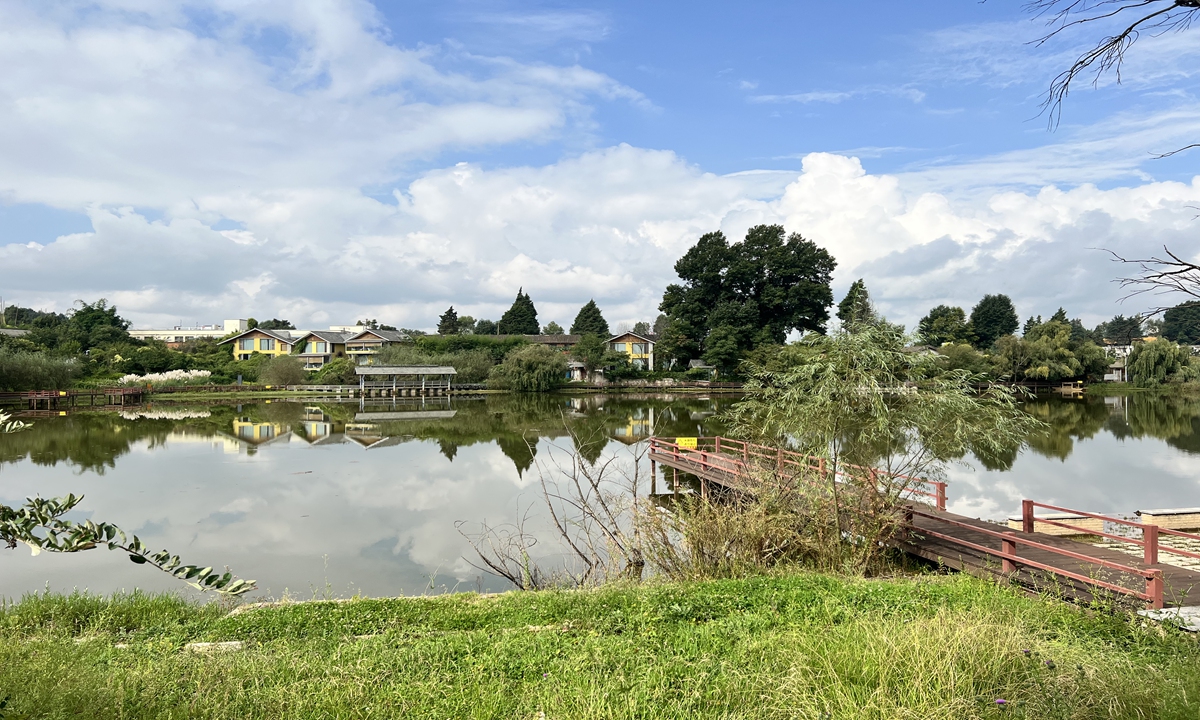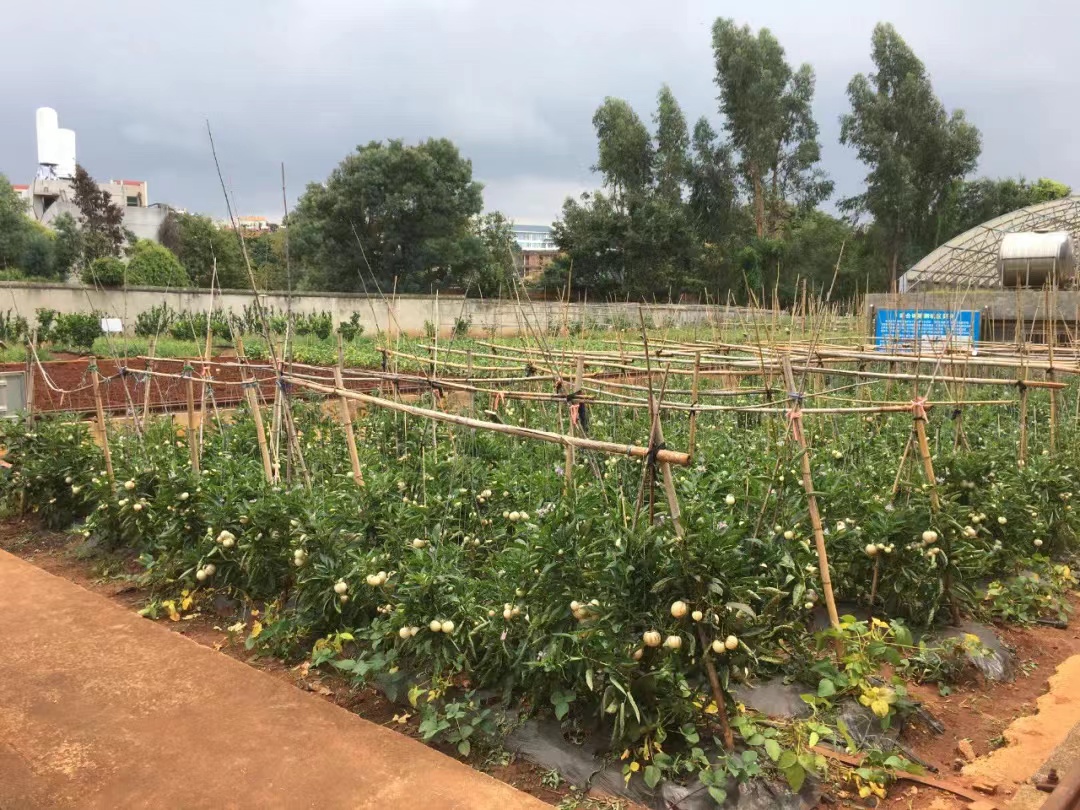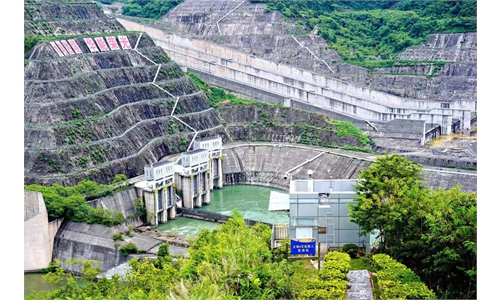
A park in Kunming,Southwest China's Yunnan Province, shows the scientific achievements of soil and water conservation. Photo: Cao Siqi/GT
“Since the irrigation test center began its construction in 2016, we have completed experiments on over 20 types of plateau crops and accumulated the basic observation data that could provide scientific guidance on irrigation water use for local specialty agriculture,” said Wang Jie, a senior official from the Yunnan Academy of Water Sciences, showing a bunch of fresh tomatoes, chili and ginseng fruit to the Global Times reporters with proud smiles.
On a sunny autumn day, a media group, including both Chinese and foreign journalists, organized by Changjiang Water Resources Commission of the Ministry of Water Resources, as well as Lancang-Mekong Water Resources Cooperation Center, which was established in 2017 in accordance with the Sanya Declaration of the First Lancang-Mekong Cooperation Leaders’ Meeting in 2016, toured the irrigation test center station in Kunming, capital of Southwest China’s Yunnan Province to take a closer look at how the province, with large water resources but also a serious water and soil erosion problem, tackled the problem and turned their local “erosion area” to a “green cornucopia.”
Stepping into the station, they saw a flushing watershed area. A field edge ridge, water storage pool, diversion pipe and drainage ditch, all these facilities have effectively helped reduce soil erosion and support agricultural production.
“We are conducting observations on more than 20 types of corps including vegetables, flowers and fruit. Look at these oranges, for example, we are doing the experiment on a land of about 12,000 acres[800 hectares],” Wang said.
According to Wang, the experimental field could help provide valuable data for how much water the plants need to grow and how to adjust the water supply in order to save the resources as much as possible.
Moreover, the center has also been dedicating efforts to the research of water conservation for plants in the Lancang River basin. “We have applied for a water project to UNDP with the aim of offering experience, concepts and technologies to neighboring countries alongside the Lancang-Mekong River,” Wang said.

Photo: The irrigation test center
Epitome of efforts
Wang’s test station is only one of a dozen in Yunnan. It is also an epitome of the province’s constant efforts to solve the water and soil erosion problem in the past years with the latest data showing that a total of 5,307 square meters of land suffering from the problem have been conserved in 2021.
But it is also more than that.
A 300,000-square-meter garden park in Kunming also shows the expertise and scientific achievements of soil and water conservation in Yunnan. The park, located in the Kunming Airport Economic Zone and covering an area of 500 mu (33 hectares), displays the soil and water conservation measures with modern and photoelectric technology. Here the Global Times reporters experienced the vicissitudes of the ecological environment through strong wind and heavy rain weather demonstrations.
In the city of Pu’er, the Global Times took a glimpse of how a pilot project could ease water shortage and save resources by integrating urban and rural water supply. By visiting the Nandao River water plant, the Global Times reporters learned that through the rural centralized water supply project, the local government has built a water treatment plant with a daily water supply of 4,000 square meters and a 42.54 kilometers water distribution pipe network.
The construction of the project started on March 14. Upon completion, the project will effectively solve the drinking water problem for 12,796 people of 2,018 households and 5,823 livestock in two villages.
Yunnan is a province with large water resources, but is also one of the provinces suffering disasters caused by soil erosion in China. Serious soil and water loss leads to the destruction of water and soil resources, the deterioration of the ecological environment, the aggravation of natural disasters and the threat of ecological security, flood control safety, food security, drinking water safety and living environment.
Over the years, Yunnan has continued to carry out land greening initiatives, taking small river basins as a unit, making unified plans for mountains, rivers, fields, forests and roads, promoting comprehensive control of rocky desertification and soil erosion, and strengthening the protection and restoration of wetlands.
Through all these efforts, land productivity in the province has been greatly increased, natural disasters have been mitigated, land use and rural industrial structure have been rationally adjusted, and local agricultural production conditions have been effectively improved.

Workers make immortal flowers at a botanical museum in Kunming, capital city of Yunnan Province. Photo: Zhang Weijia
Shared wisdom
Yunnan’s soil and water conservation expertise has achieved remarkable results locally and has been promoted throughout the country. Moreover, relevant experience has taken root in the Lancang-Mekong region under the Lancang-Mekong Cooperation (LMC) mechanism.
From 2020 to 2022, with the support of the Special Fund for Lancang-Mekong Cooperation of the Asia Cooperation Fund of China’s Ministry of Foreign Affairs, a series of projects of “Demonstration of Integrated Management of Typical Small Basins in the Lancang-Mekong Countries” have been implemented in three phases, with each lasting for one year. The first-phase and second-phase projects were completed in 2020 and 2021 in Phongsaly Province, Laos.
Phongsaly Province is located between the northernmost tip of Laos and borders Yunnan, and it has been the connection between China and Laos since ancient times. Located in the Nam Ou River Basin surrounded by mountains, it is in steep slopes and deep valleys. Dangerous terrain and blocked traffic have preserved the original ecology of Phongsaly but also caused great obstacles to the livelihood development for the local people. Many people live in remote mountainous areas and still follow the slash-and-burn lifestyle. For a long time, it has been difficult for residents to live and improve their living standards.
Following the idea of green and sustainable development, combined with local surveys in villages, the project team has developed an integrated management plan for small basins suitable for local villages and the water conditions and the plan has been approved by local governments.
The team has now set up reserve boundary stakes and notice boards, encouraging the public to protect water resources. It also built dams to reduce soil erosion in a bid to effectively and reasonably protect soil and water resources. Water purification equipment was installed so as to improve the safe drinking water of villagers while garbage collection and treatment stations were constructed to effectively prevent environmental pollution.
Village chiefs said that the local people were full of expectations for the demonstration project of integrated management of small basins, and hoped it could lead them toward poverty alleviation and sustainable development.
From the Qinghai-Tibet Plateau to the tropical rainforests in Xishuangbanna, flagship species such as black-and-white snub-nosed monkeys, Asian elephants and green peacocks are seeing the recovery of their habitats in Yunnan. The soil and water conservation work in Yunnan has made a leapfrog progress .
However, there is a set of data worth paying attention to: The province covers an area of 394,000 square kilometers, among which the area of soil erosion is 100,600 square kilometers, and 116 out of 129 counties(cities and districts) in the province present karst dissolution. Among the 80.93 million mu of cultivated land in the province, those with a slope of more than 6 degrees account for 76.96 percent, and the aggravated soil erosion caused by construction projects is still inevitable.
To meet the goal during the 14th Five-Year Plan period(2021-25), which is to improve the area of soil and water erosion by 26,300 square kilometers by 2025, the province is still on the way.



